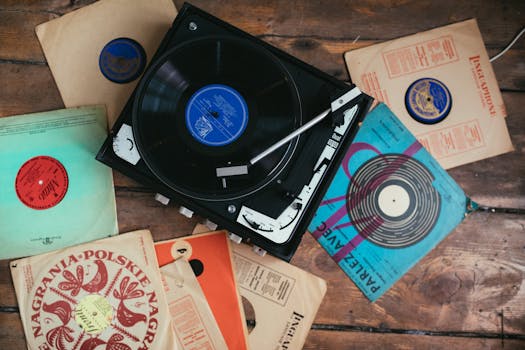Your cherished vinyl records aren't invincible. Learn how environmental factors, improper storage, and even the act of playing them contribute to their slow, agonizing demise. Discover practical tips and tricks to preserve your collection for generations to come.

Going out not with a bang, but with a hiss and a pop. That's the undramatic, yet inevitable, fate of most vinyl records. We lovingly curate our collections, meticulously searching for rare pressings and pristine copies. Yet, often we unknowingly subject these treasures to conditions that hasten their degradation. This article will delve into the sneaky culprits behind vinyl deterioration and equip you with the knowledge to protect your investment and enjoy your music for years to come.
The Silent Killers: Environmental Enemies of Vinyl
Vinyl records, while seemingly robust, are surprisingly susceptible to environmental factors. Understanding these threats is the first step in preserving your collection.
# Temperature Fluctuations: Warping and Distortion
Extreme temperature changes are a vinyl record's worst nightmare. Heat causes records to warp, rendering them unplayable or significantly affecting sound quality. Cold temperatures can make the vinyl brittle and prone to cracking. Aim for a stable temperature between 65°F (18°C) and 75°F (24°C).
- Practical Tip: Avoid storing records in attics, basements, or garages where temperature fluctuations are common. Keep them away from direct sunlight and heating vents.
# Humidity: Mold, Mildew, and Sticky Grooves
High humidity promotes the growth of mold and mildew, which can damage the record's surface and grooves. Excess moisture can also cause the paper sleeves to stick to the vinyl, leading to surface damage when separated. Low humidity, on the other hand, can cause static buildup, attracting dust and debris.
- Practical Tip: Use a dehumidifier or humidifier to maintain a relative humidity level between 45% and 55%. Store records in archival-quality inner sleeves for added protection.
# Light Exposure: Fading Artwork and Vinyl Degradation
Prolonged exposure to sunlight or artificial light can fade the album artwork and even degrade the vinyl itself. UV radiation breaks down the polymers in the vinyl, making it more brittle and susceptible to damage.
- Practical Tip: Store records in a dark, cool place away from direct sunlight. Consider using UV-resistant sleeves or display cases for records you want to showcase.
The Perils of Play: Handling and Maintenance Matters
Even the act of playing your records can contribute to their wear and tear if not done properly. Good handling and maintenance practices are essential for extending the life of your vinyl.
# Improper Handling: Scratches, Fingerprints, and Surface Damage
Careless handling is a major cause of scratches and surface damage. Touching the playing surface of the record with your bare hands leaves behind oils and dirt that can attract dust and degrade sound quality.
- Practical Tip: Always handle records by the edges and the label. Use clean, lint-free gloves or a microfiber cloth when handling records to minimize fingerprints and surface contamination.
# Dirty Needles: Abrasive Wear and Tear
A dirty stylus acts like sandpaper, grinding away at the grooves of your records. Regular stylus cleaning is crucial for preventing damage and maintaining optimal sound quality.
- Practical Tip: Clean your stylus regularly with a stylus brush and a stylus cleaning solution. Replace your stylus according to the manufacturer's recommendations.
# Worn-Out Equipment: Damage From a Faulty Turntable
A turntable with a worn-out stylus, misaligned cartridge, or faulty motor can damage your records. Regular maintenance and calibration of your turntable are essential for protecting your vinyl.
- Practical Tip: Invest in a quality turntable and have it professionally serviced regularly. Check the tracking force and anti-skate settings to ensure proper stylus alignment.
Storage Solutions: The Foundation of Preservation
Proper storage is the cornerstone of vinyl preservation. Choosing the right storage method can significantly extend the life of your collection.
# Vertical Storage: Preventing Warping and Distortion
Storing records horizontally stacks the weight of the records on top of each other, leading to warping and distortion. Vertical storage allows the records to stand upright, distributing the weight evenly and preventing damage.
- Practical Tip: Store records vertically in sturdy shelves or crates. Avoid overcrowding the shelves, as this can put pressure on the records and cause them to warp.
# Archival-Quality Sleeves: Protecting Against Dust and Debris
Paper sleeves can scratch the vinyl surface and attract dust and debris. Archival-quality inner sleeves made of acid-free paper or polyethylene provide a protective barrier against these contaminants.
- Practical Tip: Replace the original paper sleeves with archival-quality inner sleeves. Consider using outer sleeves to protect the album artwork from dust and scratches.
# Proper Shelving: Stability and Support
The shelving you use to store your records should be sturdy and stable enough to support the weight of your collection. Avoid flimsy shelves that can sag or collapse.
- Practical Tip: Choose shelves made of solid wood or metal. Ensure the shelves are level and properly supported to prevent them from warping or collapsing.
Conclusion: A Legacy of Sound
Protecting your vinyl collection is an investment in preserving a piece of musical history. By understanding the environmental threats, adopting proper handling and maintenance practices, and implementing effective storage solutions, you can ensure that your records continue to bring you joy for generations to come. Don't let your vinyl collection slowly destroy itself – take action today to safeguard your musical legacy.
